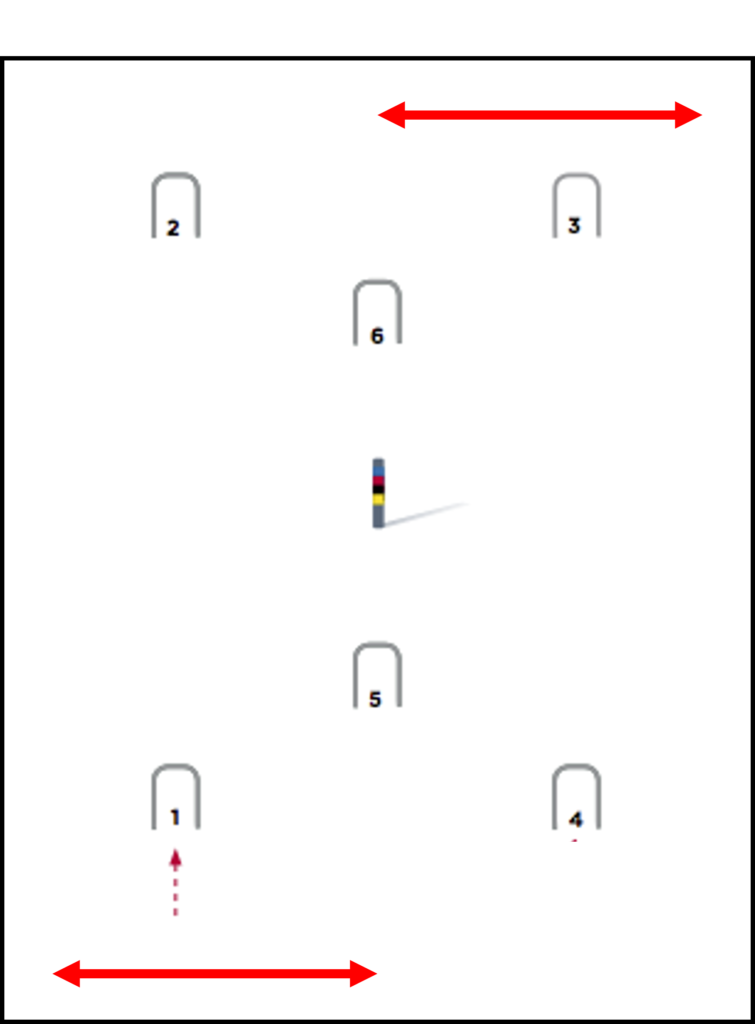Association Croquet – A Summary of the Rules
The basics:
Croquet is pretty simple.
There are four coloured balls, and two teams: red & yellow vs black & blue. Your team has to get both of your balls through all the hoops, in the right order (and in the right direction).
Each turn, you choose which of your coloured balls to play. You stick with it for the rest of that turn.
At the start of your turn, you get one shot. Normally people swing the mallet through the legs, with whatever grip is comfortable.
The stuff about extra shots:
Extra shots are the whole point of croquet. You want to chain up loads of extra shots in a turn to make any progress. There are two ways to get extra shots:
- If you hit any another ball with yours, you get to pick up yours and put it touching the victim ball. Then you get another shot with your ball! Both balls have to move in this shot. After that, you get one more again. In total, you get two extra shots from a collision: one with them touching and one when they’re apart.
- If you get your ball through the hoop it is aiming for, you get another shot.
Once you’ve hit one other ball, don’t stop there! You can hit all the other balls in turn to get loads of extra shots.
However, you can’t hit the same ball twice in a turn to get extra shots, unless you go through your hoop. Going through your hoop resets all the balls, so you can get loads of extra shots all over again!
Winning the game
To win, you have to get both of your balls through all the hoops in the right order and the right direction. You then need to hit both of your balls onto the peg in the middle. See the diagram below for direction – a half game is recommended for cuppers

Once you hit a ball on the peg, that ball is taken out of play. This means you’ve only got one ball left to use, so its a good idea to peg out both your balls at the same time to keep your options open until the last minute.
If you hit the peg but haven’t been through all the hoops, nothing happens (it’s often just a bit inconvenient).
You can peg other people out, but only if your ball is also going for the peg, so its a risky play.
Along those lines, you can also hit other balls through hoops. If it’s their target hoop it counts, but you don’t get the extra shot.
Where to start
For the first two turns (when bringing your balls on for the first time), you start 1 mallet length from the border, in the areas marked with red arrows. Yes there are two arrows; you can start from the opposite end if you want to flex your croquet knowledge on beginners.

Other border rules
The border rules are quite confusing, so feel free to come back to this section if someone hits a corker into the college flowerbeds.
- If you play a shot so that any part of a ball is overhanging the boundary line, that counts as off.
- You can CONTINUE your turn if you’ve just gone through a hoop or you’ve just hit another ball for the first time. If the latter, bring the ball on a mallet’s length, place your ball so they are touching as you would normally, and carry on.
- Going off ENDS your turn if you’ve just played a ‘croquet stroke’, that’s the shot where both balls are touching. If either ball goes off from this position, then you lose your continuation shot 🙁
- Any balls (except the one you’re currently playing) that go within a mallet’s length from a border should be immediately brought in to that distance. This doesn’t end your turn. You don’t do this with your current ball so you can get behind other balls close to the edge. At the end of every turn, any balls that went off or finished close to the borders get brought in a mallet’s length from the border.
Some niche rules (only here to settle disputes)
A ball counts as ‘through a hoop’ if none of it is sticking out the front. You can test this by sliding a leaf or £5 note down the front and seeing if it touches.
Once a ball strikes another (to get extra shots), it becomes dead. If it then carries on through a hoop or hits a third ball, nothing happens.
For doubles play, you can either alternate who takes a turn (cuppers preference), or each player can stick with a colour the whole game and each turn you can choose who plays (not great for lopsided teams).
For any other unusual situations or disputes, feel free to contact the Secretary, consult the latest handbook, or check out this great website (shoutout to Ian Plummer for putting that together). There are hundreds of rules and edge-cases, but this is designed to be a quick overview for beginners or cuppers teams who’ve turn up to their first game realising they don’t know the first thing about croquet and are wondering where the Pimm’s is.
Good luck!
